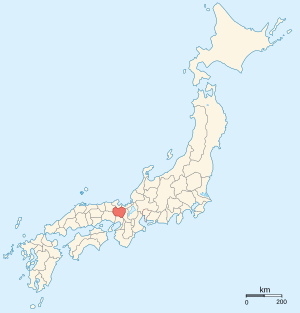Tanba Province facts for kids
Tanba Province (丹波国 (Tanba no kuni)) was an old area in Japan. It was located in what is now central Kyoto Prefecture and east-central Hyōgo Prefecture. Tanba shared borders with several other provinces, including Harima Province, Ōmi Province, Settsu Province, Tajima Province, Tango Province, Wakasa Province, and Yamashiro Province.
Its shorter name was Tanshū (error: {{nihongo}}: Japanese or romaji text required (help)). Tanba was part of a larger travel route system called the San'indō circuit. It was considered an important province and was also quite close to the capital city. People believe the main city of the province was in what is now Kameoka, Kyoto. However, its exact spot is still a bit of a mystery. The most important shrine in the province was the Izumo-daijingū, also in Kameoka. The province covered an area of about 1,283 square kilometers (495 square miles).
History of Tanba Province
A long time ago, before Japan had its modern government system, the Tanba area was ruled by local leaders called `Tanba Kokuzō`. This area included both Tanba and Tango provinces.
In the year 713, during the time of Empress Genmei, the northern part of Tanba was separated. This new area became a new province called Tango. The parts closer to the capital remained Tanba.
Tanba is a very rugged place with many mountains. It has several river basins, which are areas drained by a river and its smaller streams. Because of these mountains, it was often hard to govern the whole province as one unit. But being close to the capital made it very important for defense and travel.
During the Muromachi period (1336-1573), the Hosokawa clan were the main governors, known as `shugo`. They often ruled through other families, like the Naito clan.
Later, in the late Sengoku period (a time of many wars), a powerful general named Akechi Mitsuhide took control of Tanba. After he was defeated by Toyotomi Hideyoshi, the province was ruled by relatives of the Toyotomi clan.
In the Edo Period (1603-1868), Tanba was divided into many smaller areas called `domains`. These domains were ruled by `daimyō` (powerful feudal lords). Most of these daimyō were `fudai daimyō`, who were trusted by the Tokugawa shogunate (Japan's military government). They were important for protecting Kyoto and Osaka.
Changes in the Meiji Period
After the Meiji restoration in 1868, Japan went through big changes. Tanba Province was divided into six smaller districts.
An official government report from the early Meiji period showed that Tanba had 970 villages. The total `kokudaka` (a measure of land productivity, often used to show a lord's wealth) was 331,954 `koku`. This was a way to measure the province's resources.
Gallery
See also
 In Spanish: Provincia de Tanba para niños
In Spanish: Provincia de Tanba para niños







